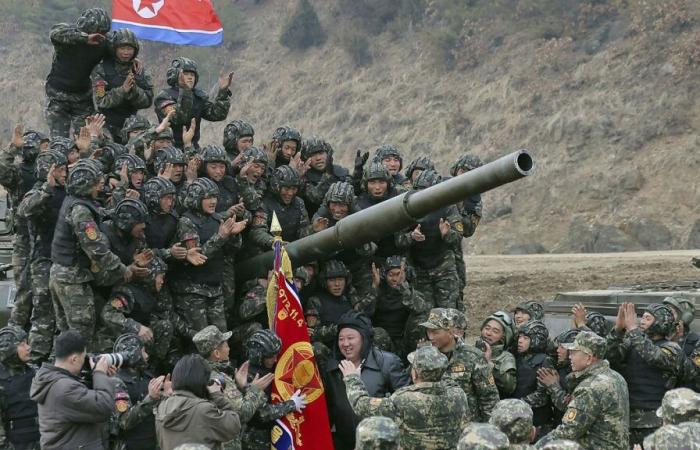According to Volodymyr Zelensky, Ukraine’s Western allies did not respond adequately to the involvement of North Korean troops in the war between Russia and Kyiv. Pyongyang, at the same time, is testing a new intercontinental ballistic missile “the most powerful in the world”.
ADVERTISEMENT
The Biden administration said about 8,000 North Korean troops are now in Russia, near the Ukrainian border, and preparing to help the Kremlin fight against Ukrainian troops in the coming days.
The new figure represents a dramatic increase from the day before, when Defense Secretary Lloyd Austin said only that “a portion” of troops had moved toward the Ukrainian border in the Kursk region , where Moscow’s forces struggled to repel a Ukrainian incursion.
It would also mean that most of the North Korean troops that the United States and its allies say were sent to Russia are now on the Russian-Ukrainian border.
“The participation of the DPRK [Corée du Nord] to the fighting against Ukraine would constitute an alarming extension of the conflict. The deployment of DPRK troops to Russia already marks a dangerous expansion of ties between Russia and the DPRK,” Robert A. Wood, deputy U.S. ambassador to the United Nations, told a UN Security Council session. security.
“Russia’s actions towards the DPRK are not only dangerous, but they run counter to its responsibility as a permanent member of the United Nations Security Council. Russia’s military cooperation with the DPRK violates numerous UN Security Council resolutions, which prohibit both arms purchases and military training from the DPRK.
The United States has estimated the number of North Korean troops in Russia at 10,000. Seoul and its allies said the number had risen to 11,000, while Ukraine put forward a higher figure of up to 12,000.
At the same time, according to Ukrainian President Volodymyr Zelensky, Ukraine’s Western allies did not respond adequately to the involvement of North Korean troops in Russia’s war against Kyiv. Russian President Vladimir Putin is “testing the reaction of the West, NATO member states and South Korea,” the Ukrainian leader said in an interview with South Korean television channel KBS. “And if there’s nothing – and I think the reaction to this has been zero – then the number of North Korean troops on our border will be increased,” he added.
Zelensky said North Korean troops had been deployed to Kursk, but had not yet taken part in hostilities.
“They are already in the Kursk region. They will use these troops. Of course, these people will die. Of course, they will do everything so that more North Korean soldiers die, which means they will push more towards the ‘before Russia So we will see these victims with you,’ he told KBS.
Deepening relationships
North Korea’s drive to deepen ties with Russia has sparked concerns around the world about the expansion of the war and the Russian military aid that will be provided in return.
The topic was at the heart of the meeting between U.S. and South Korean leaders this week in Washington, fueling fears that the presence of North Korean troops could further destabilize the Asia-Pacific region and expand Moscow’s war against Ukraine.
South Korean Foreign Minister Cho Tae-yul condemned the deployment “in the strongest possible terms” and called for the immediate withdrawal of troops.
North Korea’s belligerent actions threaten not only the European continent, but also the Korean Peninsula, and Seoul is committed to “taking necessary measures accordingly”, he said.
Questions also arise about new military technologies that North Korea could obtain from Russia in exchange for the deployment and whether it might entice other countries to send their own forces to participate in the war.
Meanwhile, the director of the United Nations Office for Disarmament Affairs told the Security Council that Russia and Ukraine continued to receive weapons, ammunition and other forms of military assistance from other countries, which fueled the fighting.
“Recent reports also indicate the presence of third-party military personnel in the Russian Federation to assist in military operations against Ukrainian forces. We urge all parties concerned to refrain from any measures that could lead to overreach and an intensification of the war,” said Adedeji Ebo.
The United States and South Korea have called on China to use its influence over Russia and North Korea to avoid escalation after Pyongyang sent thousands of soldiers to Russia. So far, Beijing has remained silent. In a rare meeting earlier this week, three senior U.S. diplomats met with China’s ambassador to the United States to convey American concerns and urge him to use his influence over North Korea to try to end cooperation, according to a State Department official, who spoke on condition of anonymity.
Pyongyang’s new missile ‘too big for war’
North Korea boasted Friday that the new intercontinental ballistic missile that she has just tested is “the most powerful in the world”a claim considered pure propaganda after experts deemed it too big to be useful in a war situation.
The intercontinental ballistic missile launched Thursday flew higher and longer than any other weapon North Korea tested. However, foreign experts say the test did not demonstrate that North Korea has overcome some of the remaining technological hurdles that prevent it from possessing functional intercontinental ballistic missiles capable of striking the continental United States.
North Korea’s Central News Agency identified the missile as a “Hwasong-19” and called it “the world’s most powerful strategic missile” and an “advanced weapon system.” The state media outlet said leader Kim Jong Un observed the launch, describing it as an expression of North Korea’s determination to respond to threats to its security.
The color and shape of the exhaust flames visible in photos of the launch taken by North Korean media suggest that the missile uses pre-charged solid fuel, making the weapons more agile and harder to detect than the liquid propellants that generally need to be fed in advance.
But experts say the photos show that both the missile and its launcher are oversizedwhich raises serious questions about their mobility and survivability in times of war.
“When missiles get bigger, what happens? Transport vehicles too. When carrier-erector launchers become larger, their mobility decreases,” explains Lee Sangmin, an expert at the Korea Institute for Defense Analysis (South Korea).
The Hwasong-19 is estimated to at least 28 meters longwhile the Advanced US and Russian intercontinental ballistic missiles are less than 20 meters longsaid Chang Young-keun, a missile expert at the Korea Research Institute for National Strategy in Seoul. He said South Korea’s warning Wednesday about an imminent North Korean intercontinental ballistic missile launch was linked to the size of the missile.
“In the event of a conflict, such exposure makes the weapon the target of pre-emptive attack by adversaries, which would pose a big survivability problem,” Chang said.
Lee Illwoo, an expert with South Korea’s Korea Defense Network, said North Korea may have developed a larger missile to carry larger, more destructive warheads or multiple warheads. If so, Lee said North Korea could have used liquid fuels because they generate greater thrust than solid fuels. He says some advanced liquid propellants can be stored in missiles for a few weeks before takeoff.
Mr Lee added that North Korea may have placed a dummy warhead on the Hwasong-19 to make it fly higher.






